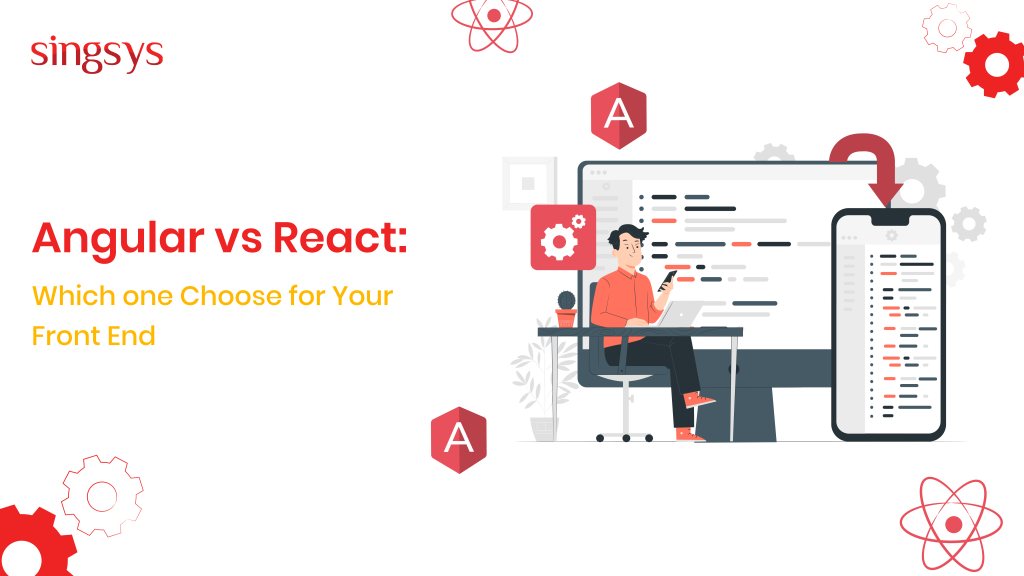Within the ever-changing field of web development, two of the most popular frameworks are Angular and React. The Google-developed Angular and the Facebook-maintained React provide robust tools for creating contemporary web applications.
For developers to choose the best tool for their projects, they must be aware of the subtle differences and variations between different frameworks. We examine the main distinctions between React and Angular in this in-depth overview, including their features, architecture, performance, and ecosystem.
What is Angular and React?
Angular: Developed and maintained by Google, Angular is a comprehensive framework for building large-scale, single-page applications (SPAs) and progressive web apps (PWAs).
It follows the MVC (Model-View-Controller) architecture and is written in TypeScript, offering a robust set of features out of the box.
React: Created by Facebook, React is a JavaScript library primarily used for building user interfaces (UIs) in web applications. Because of its component-based architecture, developers can produce reusable user interface components.
React is known for its simplicity, virtual DOM (Document Object Model), and declarative approach to building UIs.
Comparison between Angular and React
The comparison between the Angular and React are:
1. Architecture:
Angular: Angular follows the MVC (Model-View-Controller) architecture, where components represent the View, services handle business logic (Model), and controllers manage the application’s behaviour. Angular provides a more opinionated structure, with features like dependency injection and two-way data binding.
React: React employs a component-based architecture, where UIs are broken down into reusable components. It utilises a virtual DOM, which efficiently updates the actual DOM when changes occur. React’s unidirectional data flow simplifies state management and enhances performance.
2. Language and Syntax:
Angular: TypeScript, a superset of JavaScript that incorporates static typing, is used to write Angular. TypeScript offers features like interfaces, generics, and static type checking, which enhance code maintainability and scalability.
React: React primarily uses JavaScript (ES6+), along with JSX (JavaScript XML), a syntax extension that allows developers to write HTML-like code within JavaScript. JSX facilitates the creation of component-based UIs and improves code readability.
3. Performance:
Angular: Angular’s two-way data binding and digest cycle can impact performance in large-scale applications, as changes to the model can trigger updates across the entire application. Angular’s Ahead-of-Time (AOT) compilation and optimised change detection mechanism mitigate performance overhead.
React: React’s virtual DOM and one-way data flow enable efficient updates to the DOM, resulting in better performance compared to traditional DOM manipulation. Additionally, React’s reconciliation algorithm ensures minimal DOM updates, enhancing performance in complex applications.
4. Ecosystem and Community:
Angular: Angular has a robust ecosystem supported by Google and a large community of developers. It offers features like Angular CLI (Command Line Interface) for scaffolding projects, Angular Material for UI components, and RxJS for reactive programming.
React: React boasts a vibrant ecosystem with numerous third-party libraries and tools, including React Router for routing, Redux for state management, and Styled Components for styling. The React community is active and diverse, contributing to the library’s growth and evolution.
5. Learning Curve and Documentation:
Angular: Angular has a steeper learning curve compared to React, primarily due to its comprehensive feature set and opinionated structure. However, Angular’s official documentation is extensive and well-maintained, providing comprehensive guidance for beginners and experienced developers alike.
React: React’s learning curve is relatively gentle, especially for developers familiar with JavaScript and HTML. Its minimalist API and focus on components make it easier to grasp. React’s documentation is clear, concise, and supplemented by a wealth of community resources and tutorials.
When to choose React and Angular?
The decision between React and Angular is determined by several variables, such as long-term objectives, ecosystem preferences, development team experience, and project needs.
Here are some scenarios where you might opt for React or Angular:
Choose React if:
1. UI-Centric Applications: React is an excellent choice for projects focused on building dynamic user interfaces and single-page applications (SPAs). Its component-based architecture and virtual DOM make it well-suited for creating interactive and responsive UIs.
2. Simplicity and Flexibility: If you prefer a lightweight and flexible library that allows you to make your own architectural decisions, React may be the way to go. Its minimalist API and unidirectional data flow provide developers with more freedom and flexibility in structuring their applications.
3. Large Ecosystem and Community: React has a vast ecosystem of third-party libraries, tools, and community-driven resources, making it easy to find solutions to common problems and integrate with other technologies.
4. JavaScript Proficiency: If your development team is proficient in JavaScript and comfortable with JSX syntax, adopting React can streamline the development process and reduce the learning curve.
Choose Angular if:
1. Comprehensive Framework: Angular is an excellent choice for building large-scale, enterprise-level applications with complex requirements. Its opinionated structure, built-in features like dependency injection and two-way data binding, and comprehensive tooling make it well-suited for such projects.
2. Type Safety and Maintainability: If you prioritise type safety, code maintainability, and scalability, Angular’s use of TypeScript can be advantageous. TypeScript’s static typing and advanced features help catch errors at compile-time and improve code quality in large codebases.
3. Built-in Features: Angular comes with a range of built-in features, including routing, forms, HTTP client, and testing utilities, which can accelerate development and reduce the need for third-party dependencies.
4. Enterprise Support: If you’re working on projects that require long-term support, stability, and enterprise-level backing, Angular’s support from Google and its commitment to backward compatibility may be appealing.
Ultimately, the decision between React and Angular should align with your project goals, team skill set, and preferences. It’s also worth considering factors such as community support, ecosystem maturity, and future scalability when making your choice.
FAQs
Q1. Can we use React with Angular? While it is technically possible to use React with Angular, it is not recommended as they are fundamentally different frameworks. React is a library for UI development, while Angular is a complete structural framework that includes features like data binding, dependency injection, and routing.
Q2. Is Angular better than React? It depends on the specific needs of the project. Angular is better suited for complex enterprise-grade apps that require features like data binding, dependency injection, and project generation. React is better suited for building interactive UI components with frequently variable data. In terms of performance, bundle sise, and backward compatibility, React outperforms Angular.
Q3. Should I learn React before Angular? There is no specific order in which to learn React and Angular. It depends on the specific needs of the project and personal preference. If you are interested in building interactive UI components with frequently variable data, then React may be a good place to start. If you are interested in building complex enterprise-grade apps that require features like data binding, dependency injection, and project generation, then Angular may be a better choice.
Q4. Is Angular built by Google? Yes, Angular is developed and maintained by Google. It is a complete rewrite of AngularJS from the same Google engineers’ team. Angular is constantly updated and is backed by a massive community of developers.
Q5. Is React more in demand than Angular? According to a survey conducted by Stack Overflow in 2021, React is more popular than Angular. However, both frameworks are widely used and have their advantages and disadvantages. The particular requirements of the project will choose which of React and Angular to use.
Conclusion
Angular and React, both offer powerful tools for web development, each with its own set of strengths and considerations. Angular provides a comprehensive framework with built-in features like dependency injection and two-way data binding, making it suitable for large-scale applications with complex requirements.
On the other hand, React’s simplicity, virtual DOM, and component-based architecture make it ideal for building dynamic user interfaces and single-page applications. Ultimately, the choice between Angular and React depends on factors such as project requirements, developer expertise, and ecosystem preferences.
By understanding the differences outlined in this guide, developers can make informed decisions when selecting the right framework for their next web development endeavour.
About The Author
With a profound understanding of search engine optimisation intricacies, she brings insightful perspectives to our content. Her experience in the field of marketing adds a valuable layer to her work.
Related Posts...
Software DevelopmentWebsite development
Sep 30th, 2025
The way businesses build and deliver digital experiences has evolved drastically over the last decade. In 2026, one of the most transformative approaches leading this evolution is headless web development. […]
Read more
Aug 26th, 2025
While remote work has become the norm, it has its own challenges: communication gaps, project mismanagement, and reduced team bonds. Have you ever struggled to keep your team aligned while […]
Read more
Jun 12th, 2025
In the world of technology, the title “Principal Engineer” carries weight. It signifies not just advanced technical capability but also leadership, vision, and strategic impact. For many software engineers, this […]
Read more


